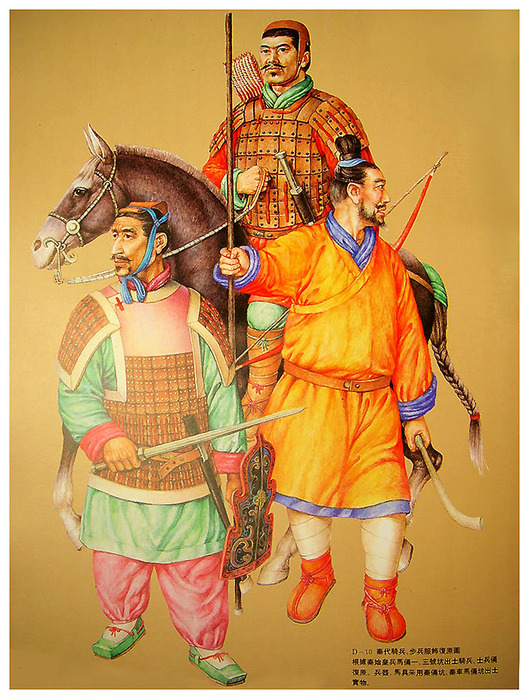Western Hsia (Tây Hạ) Tanguts
When he ascended the throne, Hui-tsung succeeded to a legacy of aggressive expansionism along the north-western frontier. In the 1070s, Shen-tsung had initiated Sung military incursions into Tangut territory, only to be mired in an inconclusive war of attrition. The premature end of Shen-tsung’s reign was perhaps hastened by the bloodbath of Yung-lo ch’eng in 1082, which broke the emperor’s spirit and ruined his health. However, during his personal rule, Che-tsung and his ministers had overturned Dowager Empress Hsüanjen’s policy of appeasement, ultimately succeeding in undermining the power position of the Hsi Hsia. Pursuing an “advance and fortify” (chin-chu) strategy of occupying enemy territory and holding it with strategic fortifications, Sung forces had soundly defeated the Tanguts in the climactic battle of P’ing-hsia in 1099.
But even if Hui-tsung desired to follow in the footsteps of his father and older brother, his hands were tied. He was constrained not only by a peace treaty concluded in the last months of Che-tsung’s reign but also by the pacifistic presence of Dowager Empress Ch’in-sheng and the ascendant anti-reformists. In the first years of the Hui-tsung reign, opinion at court turned against the adventurism of the Chang Tun ministry and favored a return to the accommodationist border policy of the Yüan-yu regency. When Chang was indicted for political crimes and dismissed from the councilorship in 1101, the conservative censor Ch’en Kuan accused him of “delighting in the deployment of troops and opening up great border rifts.” Perhaps the greatest military failure of Chang’s ministry was the collapse of an invasion of the Tibetan stronghold of Ch’ing-t’ang (modern Hsi-ning2) in the Huang-shui valley east of Lake Kokonor (Ch’ing-hai), which left Sung troops stranded deep behind enemy lines. In the third month of 1101 the Sung court admitted defeat in the Ch’ing-t’ang campaigns by completely withdrawing from the Huangshui valley, which policy makers had hoped to annex as part of Hsi-ho military circuit, and returning it to the Tibetans. After Chang Tun fell from power, an increasing number of remonstrators were emboldened to memorialize against the misguided irredentism of his ministry. True to form, this peace lobby argued that the campaigns of the late 1090s had wasted the empire’s limited military and fiscal resources to occupy an empty and unproductive swath of mountainous territory in the far northwest.
But once Hui-tsung began his personal rule, he adopted the expansionist border policy of his imperial predecessors. With the death of Dowager Empress Ch’in-sheng and the banishment of the anti-reformists from court, he and his ministers were unrestrained to make further incursions into Hsi Hsia territory. When Ts’ai Ching was appointed chief councilor in 1102, he convinced the emperor to commit to military campaigns without end on the north-western frontier. The next year, troops were mobilized for a revival of the Ch’ing-t’ang campaign, to be commanded by Wang Hou, the son of Shentsung’s onetime military advisor Wang Shao. Wang had devised a two-pronged invasion strategy, simultaneously pushing into the valleys of Ch’ing-t’ang and the highlands of Heng-shan. Rising meteorically from collecting artwork for Hui-tsung to commanding his majesty’s armed forces, the eunuch T’ung Kuan was appointed Wang’s second-in-command.
In the valleys of Ch’ing-t’ang, Wang and T’ung pursued a blitzkrieg strategy, committing a massive force to besiege and reoccupy strategic outposts that had been surrendered several years before. In the sixth month of 1103, Sung forces recaptured Shan-chou3 (the old Ch’ing-t’ang) and Huang-chou and dozens of attached fortifications. Wang claimed that this move had pacified an area of fifteen hundred square li (about 65 square miles), which supported a population of a hundred thousand, belonging to more than twenty different tribes. By the end of 1104, native resistance was extinguished, and the independent rulers of K’uo-chou and Ch’ing-t’ang (soon renamed Hsining- chou) surrendered. Hui-tsung honored Wang Hou and T’ung Kuan for conquering the region, which afforded the Sung control over the southern border of the Hsi Hsia and brought an estimated seven hundred thousand subjects under direct imperial administration. In 1104 and 1105, Hsi Hsia forces reacted defensively to the Sung invasion, which threatened their south-western border and cut off their empire from Tibetan territory. Launching pinprick attacks on Sung stockades, and later sending armies of a hundred thousand men to besiege fortifications in Huang-chou and Lan-chou, the Tanguts failed to wrest Ch’ing-t’ang away from Sung domination. Most of the credit for this military triumph went to T’ung Kuan, who replaced Wang Hou as supreme commander over the entire north-western frontier in the first month of 1105. In many ways, T’ung Kuan’s rise to power at court resulted from his victorious involvement in the Ch’ing-t’ang campaigns, which, in Paul Smith’s assessment, “promoted Hui-tsung’s continuing dream of pursuing his father’s irredentist vision.”
